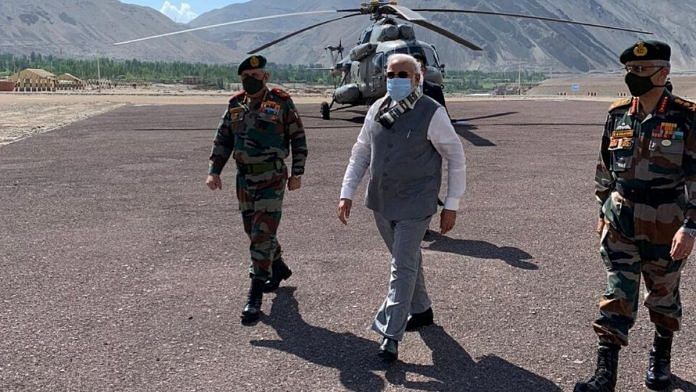New Delhi: From a ‘sorry state of India’s combat preparedness’ as claimed by former Army Chief General V.K. Singh and the Parliamentary Standing Committee admitting “critical shortages” in 2012, to now, India’s armed forces have come a long way.
Defence and military affairs has been a key focus area of the Narendra Modi government over the last eight years and there is no doubt that the three Services – Army, Navy and the Air Force – are better equipped and more prepared to fight a conventional war than they were in 2014.
The Modi government has gone in for several key purchases that were pending for years, simultaneously pushing for Atmanirbarta in the defence sector. Be it the new SiG 716 rifles from the US for the infantry, the Rafale jets from France for the Air Force or the Chinook heavy lift and Apache attack helicopters or the S 400 air defence system from Russia, the Modi government has pushed for better equipment.
And the big indigenous purchases include the K9 Vajra guns, which has added to the artillery fire power, besides the push for missile capabilities, both nuclear and conventional.
The government has also increased the financial powers given to the Service Headquarters to buy items they deem necessary without having to go through the long and convoluted procurement process filled with red tapism.
The government also brought in the biggest change in decades – creation of the post of Chief of Defence Staff (CDS) for a united armed force over individual Services working in their own silos.
However, many of the purchases underline the piecemeal approach of the government. These might have made the armed forces better-equipped but they are still left wanting for more.
As former Army Commander Lt Gen H.S. Panag (retd) noted in his recent column for ThePrint: “standalone military reforms have been conceptualised under the Modi government but for inexplicable reasons have not been executed.” What has really worked for the armed forces is that they are now out of a decision paralysis that had hit them during the UPA 2 government.
Also read: Shah’s right, India lacks formal defence policy. Past govts were busy avoiding liability
Rafales to Chinook: too little too late
I had argued previously that a long period of political stability in the defence ministry came during the UPA government when A.K. Antony was in charge – from October 2006 to May 2014. But even though he was regarded as ‘Mr Clean’, Antony’s tenure saw scams, crises, and an overall sense of sluggishness. Under his leadership, the defence ministry had come to a standstill vis-a-vis decision-making.
When Modi came to power in 2014, the military was still heavily dependent on systems that were acquired in the 1980s and before. Decisions on major acquisition projects such as combat helicopters, new submarines, fighter aircraft and howitzers, remained in limbo.
So, the Modi government coming in and ordering Chinooks, Apache, Romeos was a welcome development. Though in all earnest, the numbers were just too small.
The Army getting six Apaches is like a needle in a haystack. Ideally, the 22 Apaches of the IAF and the six ordered again for the men in olives should have been combined together and given to the Army alone.
Though the indigenous Light Combat Helicopter is also an option, they are not of the same class as the Apaches. And while we are still on it, bigger orders must be placed for the indigenous attack helicopters. 15 is too small a number.
The Cabinet Committee on Security (CCS) has today approved procurement of 15 Light Combat Helicopter (#LCH) Limited Series Production at the cost of Rs. 3,887 Cr along with Infrastructure sanctions worth Rs. 377 Cr. @ThePrintIndia pic.twitter.com/mRW5sBCtww
— Snehesh Alex Philip (@sneheshphilip) March 30, 2022
The makers of the Apache and Chinooks – Boeing – are in talks with the armed forces for more helicopters, something that should have been done long ago.
The Rafale has a similar story. The IAF was looking at 126 such fighters for over a decade but had to be content with just 36.
The IAF is still desperately seeking 114 new fighters, tender for which has been pending. Rather than be perturbed by the controversy surrounding the Rafale contract, the Modi government should quickly move in and decide on more fighters for the Air Force.
Such piecemeal deals don’t really work for an armed force as large as India’s. Firm decisions need to be taken and projects like new fighters or submarines for the Navy cannot be left to time.
The forces are going through a multi-billion-dollar modernisation process which involves the induction of new fighters, submarines, aircraft carriers, mid-air refuellers, tanks, armed UAVs, howitzers, assault rifles, helicopters. So the government will have to be firm and make decisions for bigger orders.
Even on the policy front, there are signs of ‘decision paralysis’ — non-appointment of a new CDS for over six months is a case in point. Ideally, the government should have taken a decision within a week of CDS Bipin Rawat’s death because this vacancy hampers reforms continuity, especially the creation of theatre commands.
The government was also supposed to come out with a National Security Strategy, which is now pending since 2018.
The counter argument is that everything takes time and one can’t expect the Modi government to have a magic wand and change things overnight. That is true. But what is also true is that it has been eight years since Modi came to power. So while defence preparedness has improved, the Indian military still lacks the ability to punch hard. This needs to change fast.
(Edited by Anurag Chaubey)






